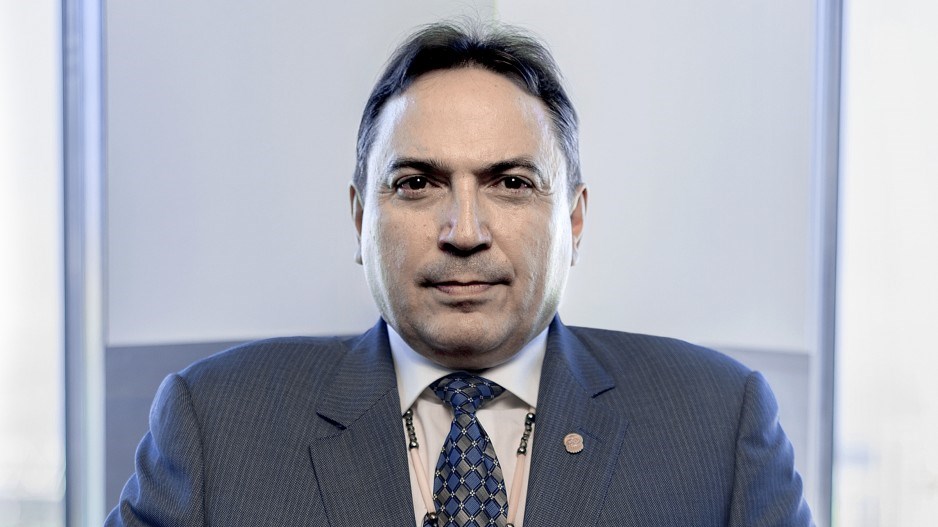“I wanted to be a professional hockey player or a country and western singer,” recalls the head of the Assembly of First Nations (AFN), a national advocacy organization that represents approximately 1.5 million people living on and off reserves in Canada.
“I still play hockey, and I love to sing,” he said. “Google me on YouTube – Perry Bellegarde.”
Passions aside – and Bellegarde can be found online belting out country classics – the bulk of Bellegarde’s career has been dedicated to politics. From 1986 through to his election as national chief in 2014, Bellegarde has served as a tribal councillor and tribal chairman, as chief of the Federation of Saskatchewan Indian Nations, and as Saskatchewan regional chief with the AFN.
Bellegarde breaks down his career into local, regional, national and international highlights. He takes the same multi-lens approach when he looks at Indigenous rights, issues and opportunities.
He is quick to credit the teams of people he has worked with over the years, but he isn’t shy about the priorities the AFN has been able to surface and promote in three years under his leadership. Examples include the federal government’s unprecedented $8.4 billion budget commitment to First Nations priorities, Canada’s commitment to adopt the United Nations Declaration on the Rights of Indigenous Peoples and even Prime Minister Justin Trudeau adopting the language of the AFN’s Closing the Gap priorities document.
“Everything he’s saying is in that document. So that shows you how much influence National Chief Bellegarde, the Assembly of First Nations has in influencing, shaping federal policy, and our legislation and our priorities,” he said.
Even though politics was never the plan, Bellegarde has made a career out of instigating change and representing First Nations and Indigenous communities.
“People say, ‘How come you’re so successful?’ I blame it all on my mum,” said Bellegarde. “My mom did a great job of raising six boys.”
Born in 1962, Bellegarde grew up on Little Black Bear First Nation in the Land of the Living Skies. The TV had one channel, and every Saturday night was Hockey Night in Canada. There was no running water, and his family would melt snow on their wood stove.
“We hunted, we trapped, and if you didn’t do those things, you didn’t survive,” he said. “We didn’t think we were poor. We had the state of mind, we thought all people lived like this.”
Bellegarde completed grades 1 to 9 on the reserve and bused into the small Ukrainian-settled town of Balcarres for the rest of high school. It wasn’t until his post-secondary studies at the Saskatchewan Indian Federated College that the national chief was really exposed to First Nations culture.
“It really had a huge impact on me listening to those elders,” he said.
“They talked about the importance of an Indian education, which is equally as important as a white-man education. And I used to always wonder what they meant. It’s basically on one hand you need kindergarten to Grade 12, university, technical vocational skills training, but equally important on the other hand is your language and your ceremonies and your traditions and your customs and who you are as a First Nations person. You need both to balance and walk in this world.”
Bellegarde uses one word to describe who he is as a person: oskâpêwis. In Cree, it means helper or servant, and the national chief has carried that title with him from role to role.
After college and university – and Bellegarde became the first treaty Indian to graduate from the University of Regina with a bachelor of business administration – Bellegarde worked as a personnel officer, and later as director of personnel, at the Saskatchewan Indian Institute of Technologies, where he overhauled and “revamped” the institute’s entire organizational structure.
“I liked that word ‘director.’ Better than a personnel officer,” mused Bellegarde.
He held that title for two years before running and winning a seat on the Touchwood–File Hills–Qu’Appelle Tribal Council. Two years into his first foray in politics, he ran for and won the seat of tribal chairman, a post he held for a decade.
“That’s all I’ve done all my life is being a helper or servant in ceremonies,” said Bellegarde. “And I equate that to leadership: you’re nothing more than a helper or servant of the people.”
“That keeps me motivated,” he said, as do the lessons he has learned from elders and mentors.
That includes the phrase “the depth of a plow,” meant to represent what First Nations elders and ancestors intended to share during land and treaty negotiations. The image has guided Bellegarde’s work, from treaty issues to revenue-sharing agreements.
“All the oil, the coal, the potash, the water, it’s still unfinished treaty business ’cause that wasn’t on the table for discussion. ‘We’d only share the depth of a plow.’”
Bellegarde said the “fire was lit” early in his political career when burial grounds were discovered under a condominium development slated for Fort Qu’Appelle. The national chief can point to many highlights from his career, but saving that land and returning it to the reserve is atop the list.
Bellegarde united the 34 chiefs from Treaty 4 to research and document the history of the land. The project was stopped, and the grounds given reserve status.
“I worked on that from 1985 right up until 1996, when we got it back in the reserve status land,” he said. “It’s the only collectively held reserve grounds in Canada. That’s a huge accomplishment, and I’m thankful for that. That’s huge. Like that’s, that’s … that’s like legacy."•




